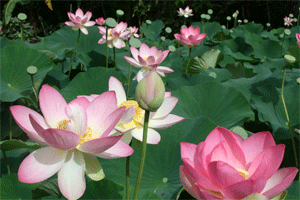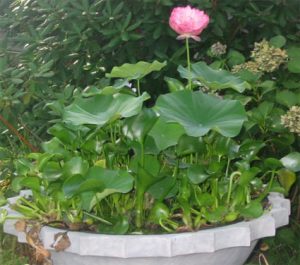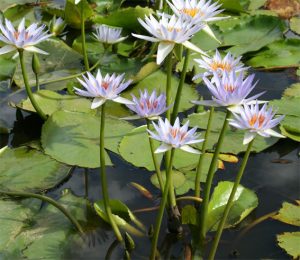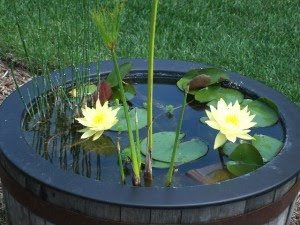LOTUS PLANTS – Nelumbo Nucifer
FOR CHINESE TRANSLATION – click here

Growing Lotus
The lotus flower is one of nature’s most beautiful creations. Nelumbo have existed on the earth for thousands of years and their distribution is widespread.They grow in a wide variety of climates from South America to Russia and everywhere between. In Asia countries such as India, China, Japan and Korea regard the lotus as sacred. In North America the lotus ranges from Southern California all the way to Canada. And in Australia you can grow lotus from the tropics of North Queensland to the Snowy Mountains and Tasmania.There are two types of lotus, the tropical and the perennial temperate varieties. Both species look almost the same, the main difference is the tropical type grows all year round and the perennial varieties go dormant during the cooler months and re-shoot in spring.

Garden Lotus
The lotus comes in a range of sizes with some varieties reaching 6 foot high (in dams and lakes) while other miniature varieties grow happily in a 6 inch bowl. In other words there’s a lotus to suit every situation. The lotus can be grown in a wide variety of ways from free standing bowls on your patio to a pond in your backyard, or a large earth lake on your property.
IMPORTANT TIPS FOR GROWING LOTUS:
- Lotus need 6 hours sun a day.
- Keep Lotus away from flowing water or fountains.
- Don’t allow your pot or bowl to freeze solid in winter.
- Don’t submerge the growing leaves.
- Re-pot your lotus in a larger container.
- Protect your young lotus from birds & crustaceans.
- Fertilize in summer.
GROWING LOTUS IN POTS, BOWLS & PLANTERS
Lotus are perennial plants that shoot in spring, then flower during summer & autumn before going dormant in winter. Lotus need 6 hours of direct sunlight to flower, so when deciding on a position for your new plant, make sure it has plenty of sunshine. Secondly Lotus are water plants and if your growing them in a pot or bowl make sure you keep the water level 5cm over the soil, but DON’T submerge the leaves. Normal tap water is fine to use. It’s also important to re-pot your lotus into a larger pot or bowl after you purchase. We suggest bowls and pots wider than 40cm with a depth of 20cm for small varieties and 80cm wide with a depth of 30cm for larger varieties.
To re-pot your lotus carefully take the plant out of the nursery pot, DON’T disturb the ROOTS. Then place your plant in the middle of your new wide pot or bowl. Carefully put topsoil (good garden soil) around the lotus and fill the container 1/3rd with the soil, DON’T use potting mix. Then add 3cm of pea gravel over the soil and fill the pot or bowl with water, remember DON’T submerge growing leaves. Fertilize with special lotus satchels once a year between December and January. To fertilize push the satchel into the edge of the bowl or pot till it reaches the bottom of the soil. Now a guide of how much fertilizer to use is…
Bowl/Pot 40cm – 60cm wide: 1 satchel.
Bowl/Pot over 80cm wide: 2 satchels.
GROWING LOTUS IN PONDS
As outlined above in BOWLS & POTS, lotus need 6 hours of sun a day to flower.We recommend you re-pot your lotus into a larger pot before you place the plant into your pond. Follow the instructions in BOWLS & POTS on how to re-pot your plant.
Then place your lotus in a sunny spot in your pond. Make sure the water level covers the top of the pot, but DON’T submerge the leaves.
Keep your lotus well away from flowing water features or fountains.
To fertilize your lotus follow the instructions in BOWLS & POTS.
GROWING LOTUS IN DAMS & LAKES
This is the most successful way to grow lotus. If the plant has the room to expand and spread, they will flower from December to early April. There are two ways you can plant your lotus in a dam or lake:
- Cut 150mm piece out of the side of the nursery pot, NOT THE BOTTOM. Then place the plant in a sunny in 30-50cm of still water near the edge of your dam. Push some mud from the dam against the side of the pot where section has been removed.
- Take lotus out of nursery pot very carefully trying not to disturb the roots. Place in a sunny spot in 30-50cm of still water near the edge of the dam. Push mud from dam around the plant.
VERY IMPORTANT: Place protective chicken wire around plant for the first 3-4 weeks if you have water birds, yabbies’ or crayfish in your dam. Your new lotus plant will follow the receding water line in your dam or lake once they get growing. Fertilize with special lotus satchels once a year between December and January.
WATER LILIES – Nymphaea

Growing Water Lilies
Water lilies add beauty and tranquillity to any situation. They can be grown in a wide variety of ways from free standing bowls on your patio to a pond in your backyard or a large earth lake on your property.
The genus Nymphaea contains about 35 species of water lilies ranging from miniatures to large growing types.
All water lilies are rooted in soil in bodies of water producing large leaves that
float on the surface along with big beautiful flowers.
Water lilies require plenty of sun to produce lots of flowers and will grow in all of Australia’s climates. Some tropical species will even grow in Tasmania.
The colours of the flowers range from soft hues to brilliant primaries with hundreds of different combinations and shades.
At the Blue Lotus Water Garden we pride ourselves on having the largest range of water lilies in Australia.
IMPORTANT TIPS FOR GROWING WATER LILIES:

Garden Water Lilies
- Water lilies need more than 4 hours a day of sunshine to flower.
- Tropical lilies need full sun all day.
- Keep lilies away from flowing water & fountains.
- Protect lilies from birds & crustaceans.
- Don’t fertilize in winter.
- Protect tropical lilies from frost.
- If growing tropical water lilies, follow extra instructions at bottom of page.
GROWING WATER LILIES IN POTS, BOWLS & PLANTERS
Water lilies are perennial plants that shoot in spring, then flower during late spring till autumn before going dormant in winter. Water lilies love the sun and need a minimum of 4 hours of direct sunlight to flower. So when deciding on a position for your new plant, make sure it has plenty of sunshine.
Water lilies like 15cm-45cm of water over the growing crown depending on the size and variety.
It’s very important to re-pot your water lily into a larger pot or bowl every 1-2 years. The best time to re-pot is during spring when the plant starts to sprout. We suggest your pot or bowl is wider than 30cm.
Carefully remove plant from old pot or bowl and the trim rhizome to one or two growing points, trim back the roots. Place 1 satchel of granulated waterlily fertilizer in bottom of your new container before you put the trimmed plant in. Then surround the plant with good garden soil with some clay mixed through. (The soil should have a pH between 6.5 – 8.0pH.). DO NOT USE POTTING MIX.
Then cover soil with 2cm of coarse sand or pea gravel. Place your re-potted lily in a sunny spot and fill with tap water 15cm – 45cm over growing crown depending on size of plant.
Remember to fertilize once a year with special waterlily granulated fertilizer by placing one satchel in the bottom of pot when repotting or push into soil at the start of the growing season. DO NOT FERTILIZE WHILE DORMANT IN WINTER.
Best varieties for Small Bowls: Helvola(cream), Little Sue(autumn), Tina (purple).
Best varieties for Medium and Large Bowls: Chromatella(cream), Souix(autumn), Colorado(salmon), Joey Tomick(yellow), Laydekeri Fulgens(red), Joanne Pring(pink), Wanvisa(salmon/yellow), Tina(purple, Daubbeniana(blue), Madame Walska(pink).
GROWING WATER LILIES IN PONDS
Place your new lily pot and all in the sunniest spot of your pond away from any fountains or flowing water features. Water lilies like 15cm-45cm of water over the growing crown depending on the size and variety. If your pond is too deep, elevate the pot.Re-pot your lily every 1-2 years and fertilize once a year. Follow the directions in POTS & BOWLS above.
GROWING WATER LILIES IN DAMS & LAKES
This is the most successful way to grow water lilies. If the plant has the room to expand and spread, they will flower from early November – April. Find a sunny spot on your dam or lake that receives a minimum of 4 hours of direct sunlight a day and away from flowing water.
To plant your waterlily, carefully take it out of the pot and place it in 30-60cm of water near the edge of the dam or lake. Then push mud from the dam around the plant.
VERY IMPORTANT – Place protective chicken wire around plant until it becomes established to protect it from water birds & yabbies.
Fertilize with special water lily fertilizer once a year in spring buy pushing satchel or tablet into soil next to plant.
TROPICAL WATER LILIES
Additional to the tips above its VERY IMPORTANT you follow these extra tips to help keep tropical water lilies healthy in temperate climates. Growing tropical plants including water lilies is a challenge in cooler climates. Tropical lilies have a 25% mortality rate in temperate regions.
Make sure you place or plant your tropical lily in a position that receives FULL SUN ALL DAY LONG.
During winter move any tropical lilies planted in free-standing bowls or pots under cover. FROST CAN KILL THEM.
It’s very important you protect dormant corms from ducks and other water birds. This is the biggest cause of mortality with tropical lilies.If planting your tropical lily in a pot or bowl. Use a large container over 80cm wide. The bigger the area of water, the less it cools overnight meaning the plant will do better.
Fertilize twice a year, once in mid-January and again in mid-February. To fertilize use special water lily granulated fertilizer and place one satchel in the bottom of your pot or bowl when repotting. Or push into the soil next to the plant at the start of the growing season. DO NOT FERTILIZE WHILE DORMANT IN WINTER.
